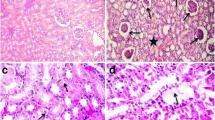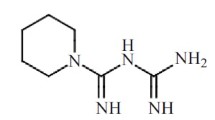Abstract
Sex- and age-related nephrotoxicity due to 1,2-dichloropropane was studied in vitro by means of renal cortical slices obtained from Wistar rats. Reduced glutathione content, organic anion accumulation (p-aminohippurate), and release of malondialdehyde (to measure the extent of lipid peroxidation), aspartate aminotransferase, γ-glutamyltransferase and lactate dehydrogenase into the incubation medium were determined. Sex differences in naive rats parameters were slight, but male were more susceptible to toxic effects of 1,2-dichloropropane than female rats; glutathione depletion, lipid peroxidation, and loss of organic anion accumulation were higher in male than in female slices. During senescence, naive male rats showed a progressive decrease of glutathione content (statistically significant from 7–9 months of age), increase of spontaneous lipid peroxidation from the same age, and increase of signs of cytotoxicity (release of aspartate aminotransferase and lactate dehydrogenase into the incubation medium) from 3–4 months of age. A loss of organic anion accumulation started from 7–9 months of age. Slices from rats of 3–4 months old showed the apparently highest susceptibility to 1,2-dichloropropane but depletion of glutathione content and loss of organic anion accumulation were at the same level in the oldest rats. The age decrease of control values caused the differences in the percentage ratio and then, apparently, a lower DCP effect. On the contrary, the increase of aspartate aminotransferase released in the incubation medium by DCP-treated slices corresponded to the age-related increase in cytotoxicity.
Similar content being viewed by others
References
Adams JR, Barrows CH Jr (1963) Effect of age on PAH accumulation by kidney slices of female rats. J Gerontol 18: 37–40
Atkinson RM, Currie JP, Davis B, Pratt DAH, Sharpe HM, Tomich EG (1966) Acute toxicity of cephaloridine, an antibiotic derived from cephalosporin C. Toxicol Appl Pharmacol 8: 398–406
Bartels MJ, Timchalk C (1990) 1,2-Dichloropropane: investigation of the mechanism of mercapturic acid formation in the rat. Xenobiotica 20: 1035–1042
Bladeren PJ van, Breimer DD, Huijgervoort JATCM van, Vermeulen NPE, Gen A van der (1981) The metabolic formation of N-acetyl-S-2-hydroxyethyl-L-cysteine from tetradeutero-1,2-dibromoethane. Biochem Pharmacol 30: 2499–2502
Beauchene RE, Fanestil DD, Barrows CH Jr (1965) The effect of age on active transport and sodium-potassium-activated ATPase activity in renal tissue of rats. J Gerontol 20: 306–310
Beierschmitt WP, Keenan KP, Weiner M (1986) Age-related susceptibility of male Fischer-344 rats to acetaminophen nephrotoxicity. Life Sci 39: 2335–2342
Berndt WO (1976) Use of the tissue slice technique for evaluation of renal transport process. Environ Health Perspect 15: 73–88
Clemens TL, Hill RN Bullock LP, Johnson WD, Sultanos LG, Vesell ES (1979) Chloroform toxicity in the mouse: role of genetic factors and steroids. Toxicol Appl Pharmacol 48: 117–130
Clifton G, Kaplowitz N, Wallin JD, Kuhlenkamp J (1975) Drug induction and sex differences of renal glutathione S-transferases in the rat. Biochem J 150: 259–262
Colucci DF, Buyske DA (1965) The biotransformation of a sulfonamide to a mercaptan and to mercapturic acid and glucuronide conjugates. Biochem Pharmacol 14: 457–466
Darnerud PO, Gustafson A-L, Törnwall U, Feil VJ (1991) Age- and sex-dependent dichlorovinyl cysteine (DCVC) accumulation and toxicity in the mouse kidney: relation to development of organic anion transport and β-lyase activity. Pharmacol Toxicol 68: 104–109
Dohn DR, Anders HW (1982) Assay of cysteine conjugate β-lyase activity with S-(benzothiazolyl)cysteine as the substrate. Anal Biochem 120: 379–386
Ecker JL, Hook JB (1974) Analysis of factors influencing the “in vitro” developmental pattern of p-aminohippurate transport by rabbit kidney. Biochem Biophys Acta 339: 210–217
Goldstein RS, Pasino DA, Hook JB (1986) Cephaloridine nephrotoxicity in aging male Fischer-344 rats. Toxicology 38: 43–53
Gray JE (1977) Chronic progressive nephrosis in the albino rat. CRC Crit Rev Toxicol 5: 115–144
Harber MH, Jennings RB (1965) Renal response of the rat to mercury, the effect of sex and sex hormones. Arch Pathol 79: 218–222
Hirsch GH, Hook JB (1970) Stimulation of renal organic acid transport and protein synthesis by penicillin. J Pharmacol Exp Ther 171: 103–108
Hook JB, Ishmael J, Lock EA (1983) Nephrotoxicity of hehachloro-1:3-butadiene in the rat: the effect of age, sex, and strain. Toxicol Appl Pharmacol 67: 122–131
Kim JK, Hirsch GH, Hook JB (1972) “In vitro” analysis of organic ion transport in renal cortex of the newborn rat. Pediatr Res 6: 600–605
Kornbrust DJ, Bus JS (1984) Glutathione depletion by methyl chloride and association with lipid peroxidation in mice and rats. Toxicol Appl Pharmacol 72: 388–399
Kyle ME, Kocsis JJ (1985) The effect of age on salicylate-induced nephrotoxicity in male rats. Toxicol Appl Pharmacol 81: 337–347
Lock EA, Ishmael J, Hook JB (1984) Nephrotoxicity of hexachloro-1,3- butadiene in the mouse: the effect of age, sex, strain, monooxygenase modifiers, and the role of glutathione. Toxicol Appl Pharmacol 72: 484–494
McCormack KM, Hook JB, Gibson JE (1981) Developmental anomalies of the kidney: a review of normal and aberrant renal development. In: Hook JB (ed) Toxicology of the kidney, Raven Press, New York, pp 227–250
Rennick B, Hamilton B, Evans R (1961) Development of renal tubular transports of TEA and PAH in the puppy and piglet. Am J Physiol 201: 743–746
Sedlak J, Lindsay RH (1968) Estimation of total, protein-bound, and nonprotein sulphydryl groups in tissue with Ellman's reagent. Anal Biochem 25: 192–205
Smith HW, Finkelstein N, Aliminosa L, Crawford B, Graber M (1945) The renal clearances of substituted hippuric acid derivates and other aromatic acids in dog and man. J Clin Invest 24: 388–404
Smith JH, Maita K, Sleight SD, Hook JB (1983) Mechanism of chloroform nephrotoxicity. I. Time course of chloroform toxicity in male and female mice. Toxicol Appl Pharmacol 70: 467–479
Tarloff JB, Goldstein RS, Morgan DG, Hook JB (1989) Acetaminophen and p-aminophenol nephrotoxicity in aging male Sprague-Dawley and Fischer-344 rats. Fundam Appl Toxicol 12: 78–91
Timchalk C, Dryzga MD, Smith FA, Bartels MJ (1991) Disposition and metabolism of [14C]1,2-dichloropropane following oral and inhalation exposure in Fischer 344 rats. Toxicology 68: 291–306
Trevisan A, Rizzi E, Bungaro A, Pozzobon L, Gioffrè F, Scapinello A, Valeri A, Chiesura P (1988) Proximal tubule brush border angiotensin converting enzyme behaviour and nephrotoxicity due to 1,2-dichloropropane. Arch Toxicol suppl 12: 190–192
Trevisan A, Rizzi E, Scapinello A, Gioffrè F, Chiesura P (1989) Liver toxicity due to 1,2-dichloropropane in the rat. Arch Toxicol 63: 445–449
Trevisan A, Meneghetti P, Maso S (1991) Thiol mediated nephrotoxicity by 1,2-dichloropropane. Third International ISSX Meeting, Amsterdam, 24–28 June 1991, P 305
Trevisan A, Maso S, Meneghetti P (1992) Renal cortical slices: an “in vitro” model for kidney metabolism and toxicity. ATLA 20: 71–76
Wabner CL, Chen TS (1987) Aging changes in renal handling of p-aminohippurate. Am J Physiol 252: R871-R877
Younes M, Siegers C-P (1981) Mechanistic aspects of enhanced lipid peroxidation following glutathione depletion “in vivo”. Chem-Biol Interact 34: 257–266
Author information
Authors and Affiliations
Additional information
The work was presented in part to the 1st National Conference of the Molecular and Cellular Toxicology Group, Siena 30. 11.–1.12.1990.
Rights and permissions
About this article
Cite this article
Trevisan, A., Meneghetti, P., Maso, S. et al. Sex- and age-related nephrotoxicity due to 1,2-dichloropropane in vitro. Arch Toxicol 66, 641–645 (1992). https://doi.org/10.1007/BF01981503
Received:
Accepted:
Issue Date:
DOI: https://doi.org/10.1007/BF01981503




